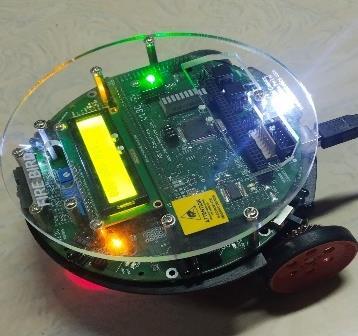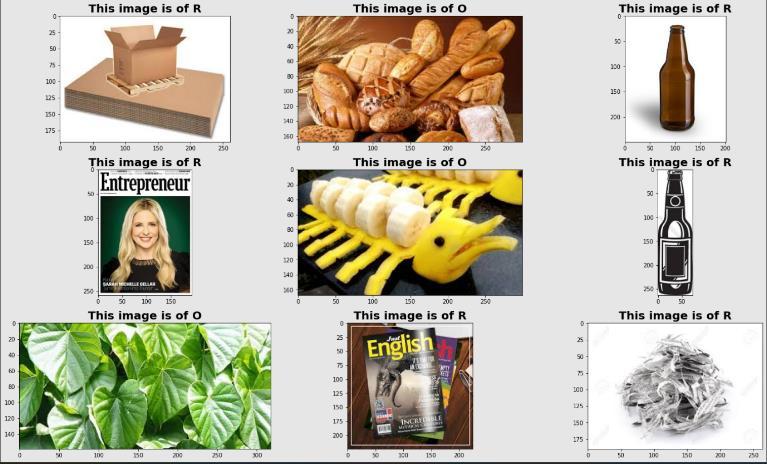
International Research Journal of Engineering and Technology (IRJET) e-ISSN:2395-0056
Volume:11Issue:09|Sep 2024 www.irjet.net p-ISSN:2395-0072


International Research Journal of Engineering and Technology (IRJET) e-ISSN:2395-0056
Volume:11Issue:09|Sep 2024 www.irjet.net p-ISSN:2395-0072
1 2Student, 3Associate Professor, 4Assistant Professor, Dept. of Artificial Intelligence and Data Science, SIT, Kariapatti, Virudhunagar, Tamil Nadu, India
Abstract - EnviRoBot is an advanced waste management system designed to address urban waste collection, sorting, and disposal challenges using Unmanned Ground Vehicles (UGVs) integrated with AI and IoT technologies. This paper presents the system's architecture, methodologies, and impact on sustainable urban waste management. Key features include real-time waste detection, automated sorting using AI algorithms, and route optimization with IoT sensors. EnviRoBot is solar-powered, promoting energy efficiency and sustainability. The prototype, built using the Firebird V ATmega2560 board, demonstrates the system's feasibility inreal-worldconditions, showcasing the potential of AI and IoT in revolutionizing waste management, contributingto cleaner andsmartercities.
Key Words: Waste Management, AI, IoT, Unmanned Ground Vehicles (UGVs), Smart Cities, Firebird V ATmega2560,PredictiveMaintenance,Sustainability.
Urban waste management is a growing challenge as cities expand. Traditional methods are often inefficient, costly, and environmentally unfriendly. This paper introduces EnviRoBot, an AI-driven waste management system that leverages Unmanned Ground Vehicles (UGVs) integrated with IoT technologies to automate waste collection, sorting, and disposal. The system is proposed to enhance operational efficiency, reduce human intervention, and promotesustainablewastemanagementpractices.
The increasing volume of urban waste necessitates innovative solutions to ensure effective management. Existing systems struggle with inefficiencies in waste sorting, high operational costs, and limited real-time monitoring. The proposed Firebird V ATmega2560-based prototype of EnviRoBot addresses these issues by integratingAIalgorithmsforsmartsortingandIoTsensors for route optimization, making waste management ecofriendly and moreefficient.
The primary objective of EnviRoBot is to develop an autonomous waste management system using Unmanned Ground Vehicles (UGVs) integrated with AI and IoT technologies. This system aims to revolutionize urban waste collection and sorting by automating the entire process, from detection to disposal. EnviRoBot seeks to enhance operational efficiency through real-time monitoring and decision-making, optimize route planning to reduce energy consumption, and utilize AI algorithms for intelligent waste sorting. A key focus is on sustainability, achieved by powering the UGVs with solar panels, thus minimizing the environmental impact. Additionally, predictive maintenance capabilities are integrated to ensure minimal downtime, while the system's data-driven approach aids in policy-making and community engagement, ultimately contributing to smarter,cleanerurbanenvironments.
TheEnviRoBotsystemisbuiltaroundUGVsequippedwith AIandIoTcapabilities.Theprototype,developedusingthe Firebird V ATmega2560 board, serves as the initial model to test and validate the system's core functionalities. The methodology involves waste detection, sorting, and collection processes, supported by advanced technologies foroptimalperformance.
The UGVs, starting with the Firebird V ATmega2560 prototype, are fitted with sensors for waste detection and identification. AI algorithms are employed for sorting waste into categories, enabling efficient disposal or recycling. IoT sensors monitor the environment and optimize the UGVs’ routes, ensuring timely and effective wastecollection.

International Research Journal of Engineering and Technology (IRJET) e-ISSN:2395-0056
Volume:11Issue:09|Sep 2024 www.irjet.net p-ISSN:2395-0072

AI algorithms are used for waste categorization based on size, material type, and other characteristics. IoT sensors provide real-time data, which informs the UGVs’ movements,reducingenergyconsumptionandtraveltime.
The integration of AI and IoT facilitates adaptive learning, enablingthesystemtoimproveitsefficiencyovertime.
EnviRoBot uses solar panels to power the UGVs, minimizing energy costs and environmental impact. This green approach aligns with the system’s sustainability goals and contributes to reducing the carbon footprint of urbanwastemanagement
Theinitial prototype,utilizingtheFirebirdVATmega2560 board, was developed to test key functionalities such as line following, waste detection, and basic sorting algorithms. This prototype serves as a crucial step in refining the system design, validating control algorithms, and assessing hardware-software integration in a controlledenvironment.
Automated Sorting: AI algorithms sort waste materials,enhancingtherecyclingprocess.
Real-time Monitoring: IoT sensors provide continuous feedback, allowing dynamic adjustmentstoroutesandoperations.
Predictive Maintenance: The system predicts mechanical failures and schedules maintenance, reducingdowntime.
CommunityEngagementTools:Providesdatato city authorities and communities, promoting awareness and participation in waste management.
Blockchain for Waste Tracking: Ensures transparency in waste disposal and recycling processes,enhancingaccountability.
The waste classification model was designed to differentiate between biodegradable and nonbiodegradable waste using deep learning techniques. The chosen model architecture was VGG16, a convolutional neural network, which was fine-tuned to adapt to our dataset
Thedatasetwasdividedintotrainingandtestingsets,with images resized to 60x60 pixels for uniformity. Data augmentation techniques were applied to increase the diversity of the training data, preventing overfitting and improvingmodelrobustness.
We employed the VGG16 architecture, pre-trained on ImageNet,and fine-tuned itfor our classification task. The top layers of the model were replaced to suit the binary classificationofwaste.
The model was trained with early stopping to avoid overfitting.Themodelwasevaluatedonthetestdatasetto measure its accuracy and other performance metrics. The model's performance was evaluated using accuracy, precision, recall, and F1 score. The following confusion matrixillustratesthemodel'seffectiveness.

Fig-2:Confusionmatrix

International Research Journal of Engineering and Technology (IRJET) e-ISSN:2395-0056
Volume:11Issue:09|Sep 2024 www.irjet.net p-ISSN:2395-0072

4.4 Results
The model achieved a test accuracy of 87.36%. The classification report indicated strong performance across bothbiodegradableandnon-biodegradablecategories:
Table-1: Classificationreport
Urban Waste Management: Efficient waste collection, sorting, and disposal in residential, commercial,andindustrialareas.
Large Events and Festivals: Temporary deployment for waste management in large gatherings, reducing environmental impact and promotingrecycling.
RemoteandHard-to-ReachLocations: Ideal for areas where traditional waste management methods are not feasible, providing a sustainable alternative.
Industrial Waste Management: Continuous waste handling for industries requiring uninterrupted waste management, enhancing operationalefficiency.
Environmental Monitoring: Supports environmental monitoring by collecting and analysing waste data, enabling targeted interventionsinhighwastegenerationzones.
Urban Planning and Resource Allocation: Provides valuable data to city authorities for better urban planning and efficient resource allocationinwastemanagement.
Policy Development: Data-driven insights support policy-makers in crafting regulations that enhancewastemanagementpractices.
Regulatory Compliance: Ensures transparency andaccountabilityinwastedisposalandrecycling using blockchain technology, aiding compliance withenvironmentallaws.
Community Engagement: Engages communities with real-time data, raising awareness and promoting participation in waste reduction initiatives.
Enhanced Efficiency: Automates waste sorting andcollection,reducingmanuallabour.
Sustainability: Solar-powered UGVs promote eco-friendlywastemanagementpractices.
Scalability:Thesystemcanbescaledtomeetthe needsofdifferenturbansettings.
Data-Driven Decision Making: Offers valuable insights for policy-makers through automated dataanalysis.
InitialCost: Highinitial investment forUGVsand technologyintegration.
Technical Challenges: Requires advanced technicalsupportandregularmaintenance.
Weather Dependence: Solar power efficiency canbeaffectedbyweatherconditions.
EnviRoBotsignificantlyimpactsurbanwastemanagement by introducing a highly efficient, automated, and sustainable solution that addresses the growing waste challengesofmoderncities.ItsAI-drivensortingandrealtime waste detection capabilities enhance operational efficiency,drasticallyreducingtheneedformanuallabour and associated costs. By leveraging solar power, EnviRoBot not only minimizes the environmental footprintofwastecollectionbutalsosupportsthebroader goal of sustainable urban living. The system’s predictive maintenance ensures reduced downtime, leading to continuousandreliablewastemanagementoperations.
Moreover, EnviRoBot empowers city planners and policymakers with valuable data, enabling more effective decision-making and resource allocation. Its blockchainbased tracking system fosters transparency and accountability, setting new standards for regulatory compliance in waste disposal and recycling. The integration of IoT enhances the real-time monitoring of waste levels and vehicle performance, optimizing route

International Research Journal of Engineering and Technology (IRJET) e-ISSN:2395-0056
Volume:11Issue:09|Sep 2024 www.irjet.net p-ISSN:2395-0072
planningandreducingemissionsfromunnecessarytravel. By engaging communities through interactive data and insights, EnviRoBot fosters greater public participation in waste reduction efforts, driving behavioural change towardmoresustainablepractices.
Overall, EnviRoBot not only revolutionizes waste managementbutalsocontributestocleaner,healthier,and smarter urban environments. Its adaptable design allows ittobescaledandcustomizedforvarioussettings,making it a versatile solution that can address diverse waste managementneedsglobally.
EnviroBot demonstrates how AI and IoT technologiescantransformurbanwastemanagement.The system’s innovative approach to waste detection, sorting, and collection improves operational efficiency while promoting sustainability. Future developments will focus on expanding its capabilities and integrating more advancedAIalgorithmsforevengreaterimpact.
Theauthorswouldliketoacknowledgethesupportofthe developmentteamandallcontributorswhoassistedinthe creationoftheEnviRoBotsystem.
[1] N. C. A. Sallang, M. T. Islam, M. S. Islam and H. Arshad, "A CNNBased Smart Waste Management System Using TensorFlowLiteandLoRaGPSShieldinInternetofThings Environment," in IEEE Access, vol. 9, pp. 153560153574, 2021,doi:10.1109/ACCESS.2021.3128314.
keywords: {Waste management; Monitoring; Acoustics; InternetofThings;GSM;Microcontrollers;Deep learning; Waste classification; CNN; object detection; LoRaGPS shield;InternetofThings},
[2] G. Cicceri et al., "An Intelligent Hierarchical CyberPhysical System for Beach Waste Management: The BIOBLU Case Study," in IEEE Access, vol. 11, pp. 134421134445, 2023, doi: 10.1109/ACCESS.2023.3317689.
keywords: {Climate change;Cyberphysical systems; Multirobot systems; Autonomous aerial vehicles; Computer vision;Waste management; Intelligentsystems;Oceans;Intelligent cyberphysical systems;multirobot systems;unmanned aerial vehicles;computer vision;unmanned ground vehicles;beachwastemanagement},
[3]Fire Bird V ATMEGA 2560 Hardware Manual, IIT Bombay
[4]eYantraResourcehttp://elsi.eyantra.org/resource